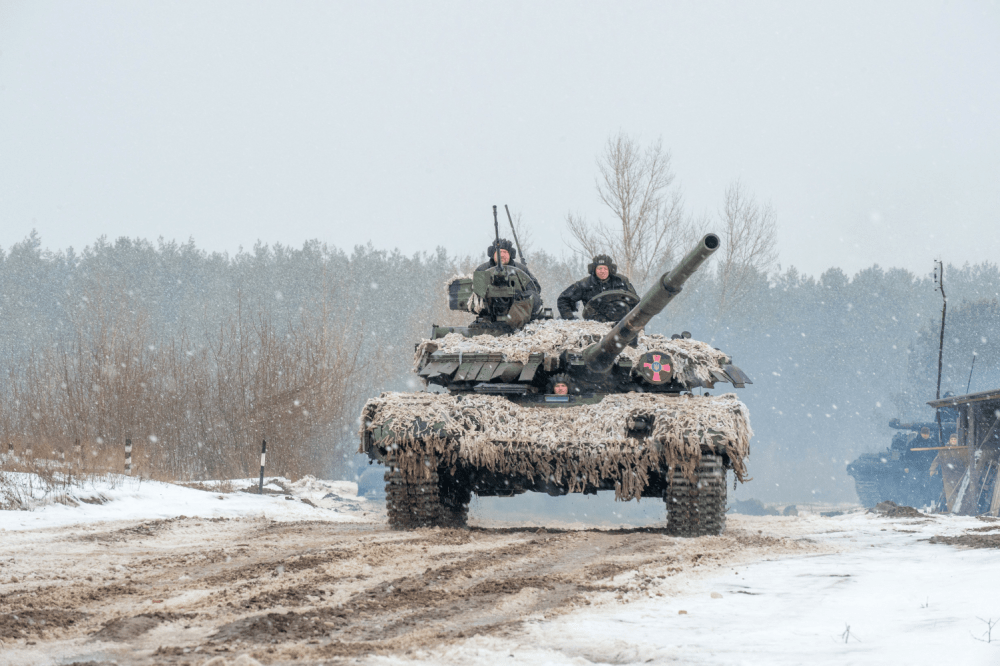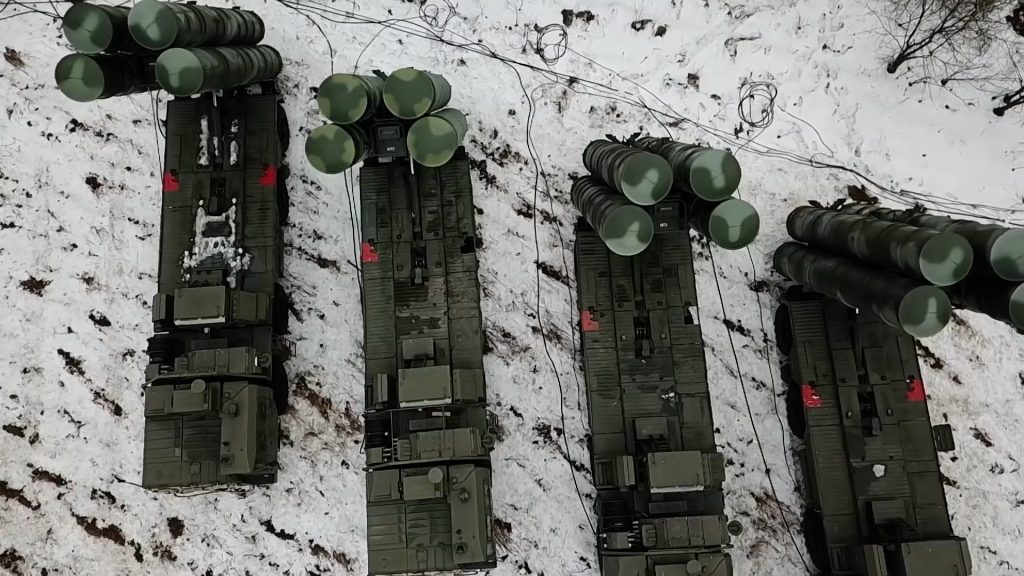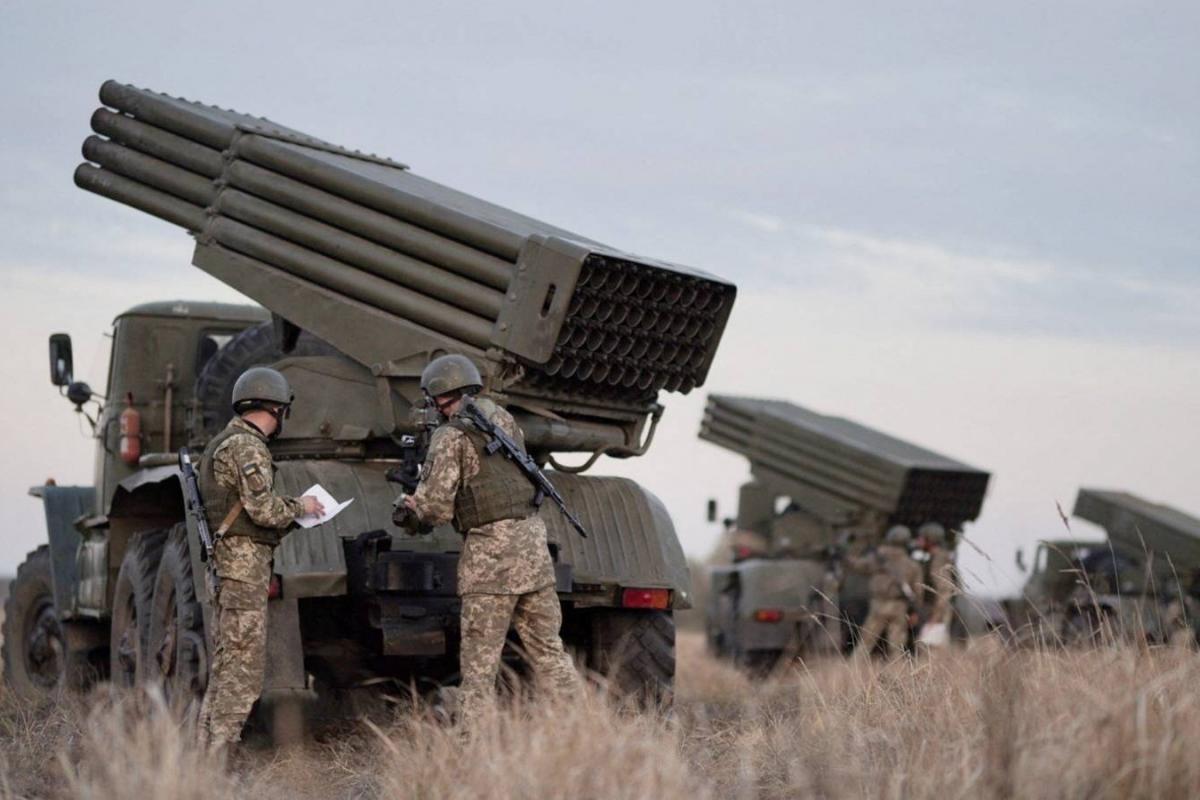•It’s not just about Moscow and Kyiv but the entire Russia-West relationship.
By Eugene Chausovsky
As military buildups continue by both Russian and NATO forces around Ukraine, European leaders have gone into diplomatic overdrive this week in an effort to mediate the Ukrainian standoff and avert war. French President Emmanuel Macron held talks with Russian President Vladimir Putin in Moscow on Feb. 7 before visiting Kyiv the next day to speak with Ukrainian President Volodymyr Zelensky, while German Chancellor Olaf Scholz traveled across the Atlantic to meet with U.S. President Joe Biden and try to get on the same page as Washington.
How Russia, the United States, and Europe are preparing for the possibility of war.
Such mediation efforts are likely only to intensify in the coming days, with many observers circling Feb. 20 as a potential decision point for Russia. That date marks the end of Russian military drills with Belarus, the end of the Beijing Winter Olympics, and the anniversary of Moscow’s invasion of Crimea back in 2014.
And that last anniversary is a reminder that the Ukrainian conflict has endured for nearly eight years despite various efforts at international mediation. Why has peace proved so elusive and mediation largely failed? And does that offer any lessons, other than pessimism, for moving forward?
A useful starting point to answer these questions is the origin of the conflict in Ukraine, which did not begin in early 2014, when Russia annexed Crimea and supported a separatist rebellion in eastern Ukraine. Rather, it started in November 2013 with the decision of then-Ukrainian President Viktor Yanukovych to abruptly pull out of talks with the European Union over a free trade and association agreement and instead turn to closer integration with Russia. This move led to monthslong mass protests in Kyiv, which in turn led to the ouster of Yanukovych in February 2014 and his replacement with a pro-Western government in Ukraine, in what came to be known as the Euromaidan Revolution.
From the outset, Russia and the West had very different interpretations of these developments. The United States and EU viewed Euromaidan as a grassroots triumph of democracy over a corrupt and authoritarian government. Russia viewed Euromaidan as an illegal coup, one that was backed by the West—and especially the United States—in efforts to expand its influence eastward. Subsequently, the separatist uprising in eastern Ukraine was viewed by the United States and EU as Russia’s direct participation in the conflict as a belligerent, while Moscow painted this uprising in the same terms that the West used in Euromaidan: a grassroots rejection of a Ukrainian government that local citizens did not support and viewed as illegitimate. While there is no question that Russia supported and participated in the separatist rebellion in eastern Ukraine, Moscow’s view—however questionable—is that this was no different from Western support for the protests in Kyiv that led to the downfall of the Yanukovych government.

These different public interpretations between Russia and the West over the origins of the Ukrainian conflict have in turn clouded the mediation process to resolve the conflict from the beginning. After the initial months of fighting in the Donbass region, a negotiation format was established in June 2014 in the form of the Trilateral Contact Group on Ukraine, which consisted of three parties—Ukraine, Russia, and the Organization for Security and Cooperation in Europe (OSCE) as a mediator. In parallel to the Trilateral Contact Group, another negotiating format was created that same month in the form of the Normandy Four group. This format included Ukraine and Russia as parties, with Germany and France as mediators. While the Trilateral Contact Group focused primarily on tactical and security issues, the Normandy Four talks were more strategically focused and were intended to deal with the broader political issues pertaining to the conflict.
The biggest complicating factor in the mediation process for both the Trilateral Contact Group and the Normandy Four was around the role of Russia in the Ukrainian conflict. Unlike in Crimea, Russia did not conduct a formal military intervention in eastern Ukraine. Instead, Russia participated in the conflict in a hybrid capacity, covertly supplying the separatists with weaponry and deploying thousands of unmarked military and security personnel to bolster separatist forces.
This had important implications for the mediation process, as the roles of the various parties were not clearly defined or mutually accepted nor was the nature of the Ukraine conflict itself. According to Russia, the conflict in Ukraine was a civil war between the Ukrainian government and the separatists, and Moscow thus advocated for the direct participation of representatives of the Donetsk People’s Republic and Luhansk People’s Republic (the Russia-backed separatist statelets in Donbass) in the negotiations. According to Kyiv, whose position was supported by the United States and EU, the war was an international conflict between Ukraine and Russia, with the separatists serving as Russian proxies.
As such, Ukraine would not accept direct negotiations with the separatists, seeing their participation as an acknowledgement of their political legitimacy. Taking Ukraine’s position into account, the separatists were excluded as formal participants from the selection process for the Trilateral Contact Group and Normandy Four negotiations, which would impact both the culture and the process of the negotiations moving forward. As a result, Russia was seen as representing the separatists within the talks by both Ukraine and the mediators, while Moscow never formally acknowledged this role and insisted on recognizing the separatists as independent actors. In a de facto sense, Russia played both mediator and belligerent, using coercive diplomacy in the form of military and financial support of the separatists as a power mediator while also formally engaging as a participant in both negotiation formats.
Despite these ambiguities, negotiations led to an agreement to end the conflict, known as the Minsk Protocol, in September 2014. The Minsk Protocol was an ambitious peace agreement, consisting of 12 points of implementation spanning the security, economic, and political spectrums. This included an immediate bilateral cease-fire, the monitoring and verification of said cease-fire by the OSCE, the release of hostages, the decentralization of political power in Ukraine via the adoption of a law on self-governance for the separatist regions, and early elections in these regions in accordance with the same law.
However, the Minsk Protocol collapsed almost immediately, with neither side adhering to the very first point of upholding a cease-fire. A renewed mediation effort to end the conflict was made early the following year, this time with the formal inclusion of France and Germany as mediators alongside the OSCE within the Minsk process. This produced the Minsk II agreement, whose provisions were largely similar to those of Minsk I, though there were more specific details on aspects such as troop and weaponry withdrawal from the line of contact. The key difference of the agreement was the timing. By the time of Minsk II, the warring parties were exhausted by fighting, military positions had become more entrenched, and the exchange of territory had become less frequent. That created some opportunity for discussion—but nevertheless, the Minsk II protocols were also not implemented, and a cease-fire broke down soon after signing.
The failure of Minsk II—which remains the theoretical basis for a political settlement in Ukraine to this day—was significantly influenced by different interpretations of the sequencing of implementation. As with Minsk I, it was not clearly agreed on whether the political components of the agreement, which included the establishment of a special status for the rebel-controlled regions, preceded the security components, which included the removal of all foreign military personnel from the region, or vice versa. According to Ukraine and the West, Russia must be the first to offer security concessions, namely in the withdrawal of its military personnel and access to monitoring of its border, in order to move forward on the political components of Minsk II. Conversely, Russia and the separatist leadership have called for political concessions by Ukraine to be made first before any security components are implemented.
These different interpretations of the Ukrainian conflict—both of its origins and in the sequencing of how it can be resolved—underpin the current standoff between Moscow and the West over Ukraine. But they also point to something much deeper that drives this standoff, which is a clash in the worldviews of Russia and the West over the entire security architecture of Europe. The Kremlin has never been comfortable with the expansion of the EU, and especially of NATO, into former Soviet territories in the post-Cold War era, and Putin views the Euromaidan Revolution in Ukraine as merely another precursor to such an expansion, whether formal or de facto.
As Ukraine’s relationship with the West and with NATO has only increased in recent years, Putin has decided there is no more time to waste and is attempting to redefine the security architecture of Europe. Ukraine is crucial, yes, but it is just one part of the real negotiation process that Russia is trying to drive, which explains the comprehensive security demands that Moscow presented to the United States and NATO in late December 2021. That the Ukrainian crisis is about much more than Ukraine thus explains why mediation efforts have proved so difficult to produce any progress, much less breakthroughs. But this could also explain why Russia’s military buildups are not necessarily just for the sole purpose of invading Ukraine but rather to force the West to reframe its functional and institutional relationship with the entire post-Soviet space.
This seems to have worked to some degree, as Macron acknowledged following his latest talks with Putin that “the geopolitical objective of Russia today is clearly not Ukraine but to clarify the rules of cohabitation with NATO and the EU.” It will be difficult for negotiations over Ukraine to make real progress unless both sides acknowledge that such negotiations aren’t just about Ukraine but about the entire relationship between Russia and the West. Reframing the standoff could avoid its most dangerous outcome, as the stakes for both sides have never been higher.
Russia’s joint exercise with Belarus reveals what a Ukraine invasion would look like
By Tyson Wetzel

The second phase of Russia’s highly anticipated bilateral military exercise with Belarus, called Union Courage ’22, kicked off on February 10. But much more than reaffirming the relationship between the two countries, it is a useful cover for the deployment of Russian high-end military equipment and an opportunity to rehearse missions applicable to a large-scale Russian invasion of Ukraine.
While imperfect, the proliferation of commercial satellite imagery and hand-held photos and video have provided a surprisingly thorough look at Russia’s military build-up. Its Ministry of Defense (MoD) has also provided insights into the types of missions these joint forces have engaged in—which allows experts to extrapolate the missions the Kremlin believes are important and to assess how they intend to execute combined arms operations in the event of a further invasion of Ukraine.
Although the execution phase of the exercise has only just begun, there is already plenty to learn from the types of forces deployed, the actions they have conducted so far, and the subjects Russia has chosen to publicize. Based on these observations, it is clear that Russia is focusing on air superiority, close air support, long-range fires, intelligence collection, and combat sustainment.
The bottom line
Russia has already deployed the forces necessary to initiate a large-scale invasion of Ukraine. It is using the Union Courage exercise to posture and prepare those forces to conduct offensive operations against Ukraine, should they be directed to invade. Based on observed deployments and training events, it is apparent that in the event of a further invasion, Russia intends to rapidly establish air superiority over Ukraine and will initiate its mechanized offensive with precision long-range fire (both from the ground and from aircraft). And it will be prepared to support that ground offensive with overwhelming support from ground-attack aircraft.
The breakdown
Air superiority. The first exercise-related force deployment was the movement of twelve Su-35S aircraft, two S-400 long-range surface-to-air missile (SAM) system divisions, and the short-range Pantsir-S1 air-defense system to Belarus. These deployments signal the importance Russia places on control of the air. The S-400 has a 250-kilometer maximum range, and its positioning of the system establishes an anti-access/area denial (A2/AD) “bubble” that reaches from its location near Brest across the border into Ukraine, including over Kyiv.
Both the Pantsir-S1 gun and SAM system provide point protection for high-value targets, and the fact that they deployed together signals that Russia intends to protect its very high-value A2/AD capabilities. The MoD announced that S-400 crews would also be training to “camouflage of launch positions,” a critical combat capability that makes it much more difficult for adversaries to target the system. Given the Su-35S’s potent air-to-ground and air-to-air capabilities, its deployment is a clear message that the Russian Air Force will shoot down any Ukrainian (or other) aircraft that flies over combat areas in the event of an invasion.
Close air support (CAS). Even before the execution phase of the exercise began, Russia had begun training to integrate air support into its ground forces. Su-25 and Yak-130 land-attack aircraft conducted live-fire training at the Brestsky Training Grounds in Belarus, according to a February 3 MoD statement, which noted how the aircraft worked with ground and airborne units and were integrated with artillery and army aviation strikes. It also pointed out that aerial reconnaissance from an unmanned aerial vehicle (UAV) was used to generate the targets for the fighter-bomber aircraft. Additionally, Russia deployed a squadron of Su-25SM aircraft, which boast improved precision attack and self-defense capabilities, to the region. These are all signals that support to ground operations will be a major focus of a potential further invasion of Ukraine.
Long-range fires. Last week, a combined force of Russian and Belarusian artillery units conducted a live-fire training event near the same training grounds involving long-range self-propelled artillery, multiple rocket launchers, and mortar units. Artillery is central to Russian military doctrine, and its live-fire training—as well as its coordination with aircraft described above—shows a large-scale Russian invasion would likely start with long-range fire supported by ground-attack aircraft.
These training events provide valuable reps both to the ground units and the CAS aircraft which will support of any major offensive. Also revealing was the February 6 publication of video footage showing two Tu-22M3 bombers over Belarus, while hand-held video surfaced a day later showing a MiG-31 equipped with a Kinzhal air-launched, hypersonic, ballistic missile landing in Kaliningrad for the first time. The former is the most upgraded variant of the long-range, supersonic, nuclear-capable bomber, and the latter could launch the Kinzhal missile from airspace over the Kaliningrad exclave and easily reach multiple high-value targets in Ukraine, including Kyiv. These deployments provide an implicit threat of nuclear retaliation in a potential expanded Ukraine conflict with US and NATO forces.
Intelligence, surveillance, and reconnaissance. In addition to the UAV’s role in identifying targets in the Brestsky live-fire exercise, the MoD also publicized the exercise preparations of its crews for the Orlan-10 UAV. That means Russia will likely rely heavily on that aircraft and its crews to detect, identify, and nominate targets for destruction by either ground-attack aircraft or ground-based fires.
Combat sustainment. The exercise also gave Russia the cover to build up combat-sustainment capabilities and forward deploy critical supplies. Russia set up field camps that included field medical services and supplies, vehicle fueling and maintenance stations, as well as “depots of fuel and ammunition,” the MoD said. These critical capabilities are required before the kickoff of any major military operation.
Strategic, operational, and tactical value
This exercise offers all three for President Vladimir Putin. Strategically, it is meant to signal strength to the West (and to deter US and NATO intervention in any potential conflict). Operationally, Russia is posturing huge numbers of forces and critical capabilities in Belarus, which geographically allows Russia to threaten Kyiv, as well as seize the opportunity to test joint and combined large-force deployment (never easy in a conflict).
Finally, there are multiple tactical reasons this exercise will benefit Russian and Belarusian forces. Besides providing the “reps and sets” needed to test and refine the interoperability required in a conflict, it will also help Russian forces familiarize themselves with the operating environment (especially those deploying from far away). The exercise also provides air and land forces with the opportunity to train to specific missions or tactical actions that they will be called upon to perform in the event of armed conflict.
In other words, it’s the perfect preparation for an invasion—if Putin wants one.
Eugene Chausovsky is a nonresident fellow at the Newlines Institute. Chausovsky previously served as senior Eurasia analyst at the geopolitical analysis firm Stratfor for more than 10 years. His work focuses on political, economic, and security issues pertaining to Russia, Eurasia, and the Middle East.
Lt. Col. Tyson Wetzel is the 2021-22 senior US Air Force fellow at the Atlantic Council’s Scowcroft Center for Strategy and Security.
Credits | Foreign Policy, Atlantic Council

